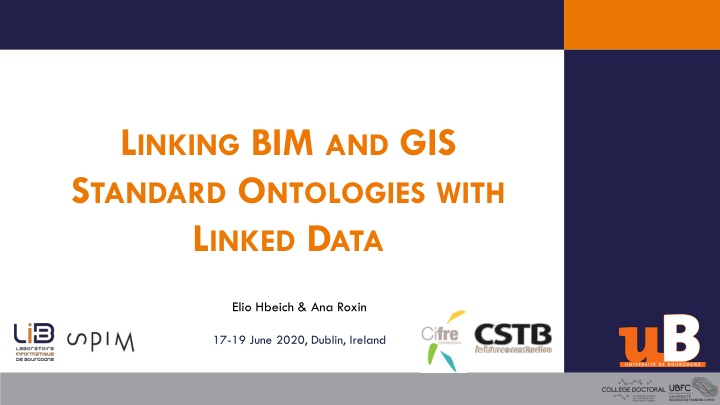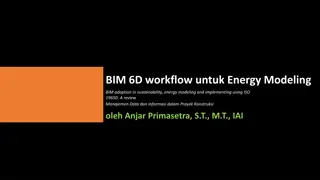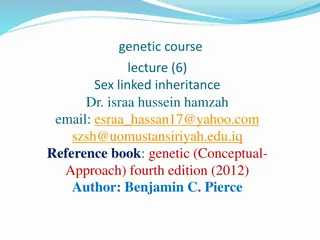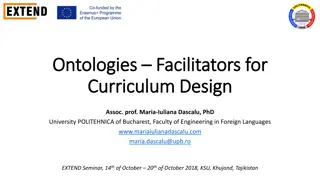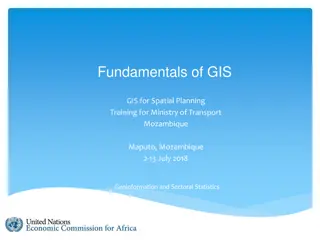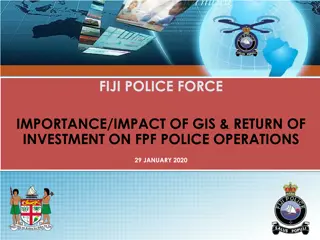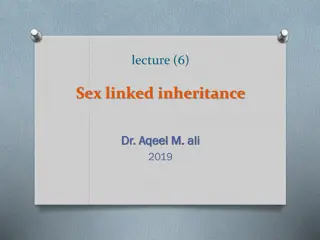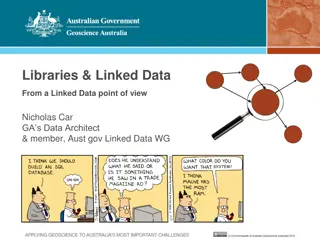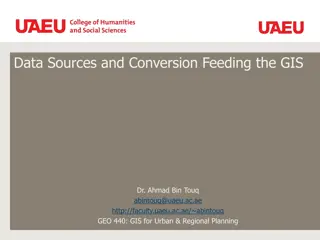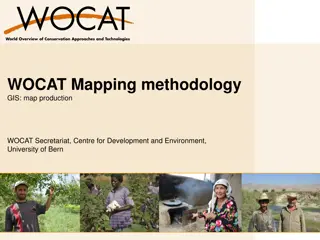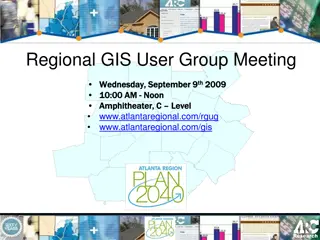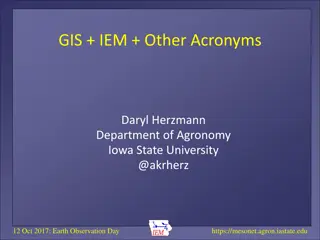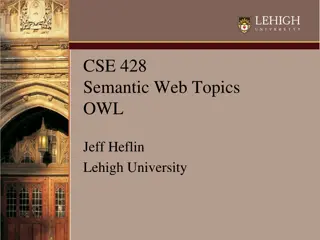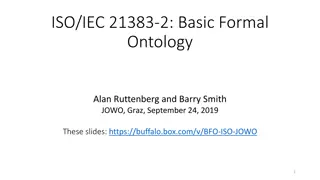Linking BIM and GIS Standard Ontologies with Linked Data
Introduction to the need for seamless data interpretation between Building Information Model (BIM) and Geographic Information System (GIS), focusing on aligning BIM and GIS standard ontologies for semantic interoperability. Addressing the challenges of data interoperability layers and the characteristics of BIM Standard Ontology (ifcOWL) and GIS Standard Ontologies like ISO 19109:2015.
Download Presentation

Please find below an Image/Link to download the presentation.
The content on the website is provided AS IS for your information and personal use only. It may not be sold, licensed, or shared on other websites without obtaining consent from the author.If you encounter any issues during the download, it is possible that the publisher has removed the file from their server.
You are allowed to download the files provided on this website for personal or commercial use, subject to the condition that they are used lawfully. All files are the property of their respective owners.
The content on the website is provided AS IS for your information and personal use only. It may not be sold, licensed, or shared on other websites without obtaining consent from the author.
E N D
Presentation Transcript
LINKING BIM AND GIS STANDARD ONTOLOGIES WITH LINKED DATA Elio Hbeich & Ana Roxin 17-19 June 2020, Dublin, Ireland
Summary Introduction BIM Standard Ontology GIS Standard Ontologies Related Work Our Approach Conclusion Usefulness and Future Work 2
Introduction Building Information Model (BIM) Geographic Information System (GIS) Need : seamless data interpretation UML to OWL translation EXPRESS to OWL translation No semantic links defined BIM standard Ontology GIS standard Ontologies IfcOWL (IFC4_ADD1) ISO/TC 211 Ontologies 3
The Issue 3 layers of data interoperability Physical (e.g. network protocols ) Syntactic (e.g. XML) Semantic (e.g. RDF, OWL) Ontologies represent the building blocks of semantic interoperability still only adopting ontologies does not fully solve semantic heterogeneity issue (Farias et al., 2015) BIM and GIS existing standard ontologies must be semantically aligned for allowing seamless interpretation of BIM/GIS models e.g. urban use case scenarios Farias T.M., Roxin A., Nicolle C. (2015) FOWLA, A Federated Architecture for Ontologies. In: Bassiliades N., Gottlob G., Sadri F., Paschke A., Roman D. (eds) Rule Technologies: Foundations, Tools, and Applications. RuleML 2015. Lecture Notes in Computer Science, vol 9202. Springer, Cham 4
BIM Standard Ontology ifcOWL ifcOWL has the following characteristics: OWL2DL Matches the original EXPRESS schema, Allows the conversion of IFC STEP files into equivalent RDF graphs. IFC ifcOWL EXPRESS OWL Algorithm in Java and C++ Class hierarchy, Object properties Etc. Simple data types Defined data types List aggregation data types, Array aggregation data types Etc. 5
GIS Standard Ontologies ISO 19109:2015 Geographic information Rules for application schema ISO 19101 ISO 19109 ISO 19103 Metamodel ISO 19111:2007 Geographic information Spatial referencing by coordinates ISO 19107 ISO 19108 ISO 19110 ISO 19111 ISO 19112 ISO 19115 ISO 19123 ISO 19137 ISO 19141 ISO 19148 ISO 19157 Conceptual Abstract Schemas ISO/TS 19130:2010 Geographic information - Imagery sensor models for geo-positioning ISO 19104 ISO 19130 ISO 19131 Conceptual Application Schemas ISO 19116 ISO 19117 ISO 19118 ISO 19119 ISO 19126 ISO 19128 ISO 19129 ISO 19132 ISO 19133 ISO 19134 ISO 19150 ISO 19159 ISO 19160 Implementation Schemas 6
Related Work No previous approach created links between BIM and ISO/TC 211standards ontologies Reference Description Limits Maps only building models Promotes one domain over the other by implementing integration approach Introduces BIM to GIS (B2G) mapping by applying perspective definition (B2G PD), element mapping (B2G EM) and LoD mapping (B2G LM) mechanisms. Kang. S et al., 2019 [1] Generates data loss Promotes one domain into the other Generates only CityGML LoD 3 building model Works on automatically generating CityGML building models from IFC using Semantic Web Technology by mapping different entities and properties. Donkers. 2013 [2] S, Most mappings focus on IfcProductExtension and the IFC concepts in the interoperability layer Focuses on building model Promotes one domain over the other Semantically integrates IFC and CityGML by conceiving the UBM ontology (Unified Building Model). Trandofmration rules were used for creating semantic relationships between IFC and CityGML. El-Mekawy et al., 2019 [3] [1] Kang, T. Development of a Conceptual Mapping Standard to Link Building and Geospatial Information. ISPRS International Journal of Geo-Information. (2018). [2] Donkers, S. Automatic generation of CityGML LoD3 building models from IFC models. (2013) [3] El-Mekawy, M., & stman, A. Semantic Mapping: an Ontology Engineering Method for Integrating Building Models in IFC and CityGML. In the 3rd ISDE Digital EART Summit, Nessebar, Bulgaria (2010). 7
Our Approach As mentioned in our previous publication (Roxin. A, & Hbeich. E. 2019) and in order to connect BIM and GIS knowledge representations we are aiming to define semantic links among: ISO 19109 ISO 19111 ISO 19130 Roxin. A, & Hbeich. E. Semantic interoperability between BIM and GIS review of existing standards and depiction of a novel approach. 36th CIB W78 Information Technology for Construction, Newcastle, United Kingdom. (2019). 9
Linking GIS Metamodel and IFC Core Layer IFC Core Layer Description ISO 19109 Description IfcRoot is the most abstract and root class for all entity definitions that roots in the kernel or in subsequent layers of the IFC specification. It is therefore the common super type of all IFC entities, beside those defined in an IFC resource schema Any Feature It represents the set of all classes which are feature types IfcRoot It recognizes all kinds of attributes: temporal, spatial geometry, spatial topology, data quality, generic metadata, and location. Further specializes the concepts of a (physical) product, i.e. a component likely to have a shape and a placement within the project context IfcProduct Extension Attribute Type IFC4_ADD1.owl Relation ISO 19109.owl IFC4.1:IfcRoot owl:equivalentClass ISO19109:AnyFeature IFC4.1:IfcProductExtension owl:equivalentClass ISO19109:AttributeType Prefix : ISO19109 ="http://def.isotc211.org/iso19109/2015/ RulesForApplicationSchema # IFC4.1 = "http://ifcowl.openbimstandards.org/IFC4_ADD1#" 10
Linking GIS Abstract Schemas and IFC Resource Definition Layer IFC Resource Layer Description ISO 19111 Description It is the non-repeating sequence of coordinate system axes that span a given coordinate space. A CS is derived from a set of mathematical rules for specifying how coordinates in each space are to be assigned to points. It is a derived coordinate reference system which has a geodetic coordinate reference system as its base CRS and is converted using a map projection. IfcCoordinateReference System It is a definition of a coordinate reference system using qualified identifiers only. CoordinateSystem (CS) It is a coordinate reference system of the map to which the map translation of the local engineering coordinate system of the construction or facility engineering project relates. Provides location and orientations to place items in a three-dimensional space. The attribute Axis defines the Z direction, RefDirection the X direction, the Y direction is derived. IfcProjectedCRS ProjectedCRS IfcAxis2Placement 3D Coordinate SystemAxis Defines coordinate system axis (axisAbbre, axeDirection, axe UnitID). IFC4_ADD1.owl Relation ISO 19111.owl IFC4.1:IfcProjectedCRS owl:equivalentClass ISO19111:ProjectedCRS IFC4.1:IfcCoordinate ReferenceSystem IFC4.1:refDirection_ IfcAxis2Placement3D owl:equivalentClass ISO19111:CoordinateSystem ISO19111:CoordinateSystemAxis. axisDirection owl:equivalentProperty Prefix : ISO 19111= "http://def.isotc211.org/iso19111/2019/CoordinateReferenceSystems#" IFC4.1 = "http://ifcowl.openbimstandards.org/IFC4_ADD1#" 11
Linking GIS Application Schemas and IFC Domain Specific and Shared Elements Layers IFC Shared Element Layer Schemas Description ISO 19130 Description It is the value of the duration of periods. Measured in seconds (s) or days (d) or other units of time. It defines the dimensionality of the coordinate space. It is restricted to have the dimensionality of either 1, 2, or 3 for the purpose of this specification It is the time value of the taken measurement IfcTimeMeasure dateTime IfcDimensionCount numberofDimensions Number of dimension IFC4_ADD1.owl Relation ISO 19130.owl ISO19130: SD_Dynamics. dateTime ISO19130:SD_DetectorArray. numberOfDimensions IFC4.1: IfcTimeMeasure owl:equivalentProperty IFC4.1: IfcDimensionCount owl:equivalentProperty Prefix : ISO 19130= "http://def.isotc211.org/iso19130/2018/SensorData#" IFC4.1 = "http://ifcowl.openbimstandards.org/IFC4_ADD1#" 12
Conclusion We aim to achieve seamless data interpretation by creating semantic links between BIM and GIS standards knowledge representation (IFC for BIM and ISO/TC 211 for GIS). As both knowledge domains are represented using OWL language, we focused on creating semantic links based on concepts and properties definitions, thus tackling terminological heterogeneity. Our work will be useful only through the acknowledgment of the scientific communities such as LDAC and the actual implementation of the semantic links from both domains (BIM ISO/TC59/SC13 and GIS ISO/TC211) 13
Usefulness and Future Work Usefulness: The mapping is not limited to a specific use case. Both domains remain independent from each other. Reduce heterogeneity between both domains ontologies. Future Work: Confront conceptual and semiotic heterogeneities mapping between BIM and GIS ontologies. Define mediator ontologies which establish terminological equivalences among schemas. Define of complex semantic mappings: which require exchanges with business experts. Integrate previous mappings created by the community. 14
Thank you for your attention QUESTIONS? Contacts: elio.hbeich@cstb.fr ana-maria.roxin@ubfc.fr 15
